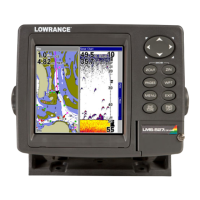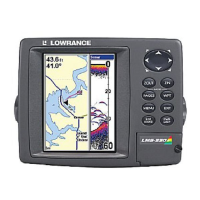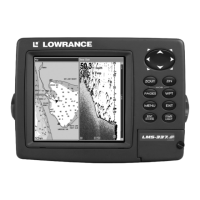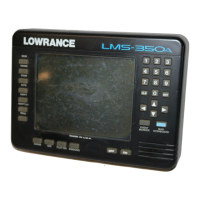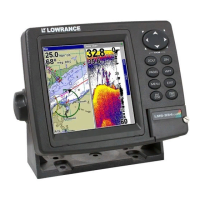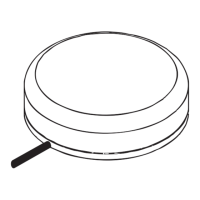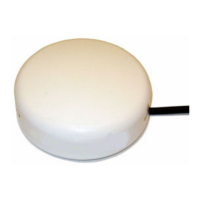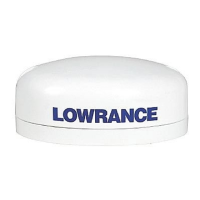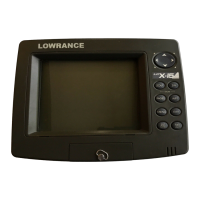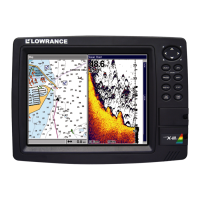Do you have a question about the Lowrance LMS-520C and is the answer not in the manual?
Details general and sonar/GPS specifications for the LMS-520c and LMS-525cDF units.
Outlines the recommended sequence for installing the sonar/GPS system components.
Provides instructions for installing Skimmer transducers on transoms, trolling motors, or hulls.
Guides on choosing the optimal mounting spot for transducers based on water flow.
Details the steps for assembling and mounting transom transducers using one-piece or two-piece brackets.
Instructions for attaching the TMB-S bracket to the transducer for trolling motors.
Guides for preparing hulls with flotation materials for shoot-thru installations.
Procedures for testing transducer locations for shoot-thru mounting.
Step-by-step guide for installing a transducer using the shoot-thru-hull method.
Explains how to connect the unit's power/data cable and different wiring branches.
Instructions on connecting the display unit to a 12-volt DC battery system.
Information about the LGC-3000 GPS module and its installation.
Steps for creating a NMEA 2000 network with T connectors and terminators.
Options for mounting the unit using gimbal, in-dash, or portable systems.
Guides on mounting the unit using the supplied bracket.
Instructions for mounting the unit in the dash using an adapter kit.
How to install and use MultiMedia Cards (MMC/SD) for data storage.
A simplified, 10-step guide to basic fish-finding operations.
Explains how sensitivity affects echo detection and how to adjust it.
Explains the ASP feature for noise rejection and its settings.
Instructions for calibrating the speed sensor for accuracy.
Describes the Colorline feature for distinguishing echo strengths and bottom types.
Guides on setting upper and lower depth limits to zoom into specific water columns.
Troubleshooting steps for the unit failing to power on.
Steps to resolve freezing, locking up, or erratic operation issues.
Troubleshooting for poor bottom echoes, erratic digital readings, or lack of fish signals.
Diagnosing issues with bottom echo loss at high speeds or erratic readings.
Troubleshooting steps when fish arches are not displayed with Fish I.D. off.
Explains electrical noise as a cause of sonar problems and how to identify sources.
A quick reference guide for basic GPS operations and navigation.
Describes GPS alarms like Arrival, Off Course, and Anchor alarms.
How to search for POIs by category, subcategory, name, or proximity.
Configuring engine-tank settings and managing devices on the network.
Access to options for tank location, fuel added, and fuel management.
Instructions for calibrating EP-10 Fuel Flow, EP-15 Fluid Level, and Suzuki Engine Interface.
How to check and calibrate fuel flow accuracy.
Details on 2-Point, 3-Point, and 5-Point calibration for fluid level gauges.
Instructions for calibrating fuel flow with a Suzuki engine interface.
How to calibrate engine trim through the Suzuki Engine Interface.
How to calibrate Trim Tabs through their Device Configuration menu.
How to reset unit features and functions to factory defaults.
Details general and sonar/GPS specifications for the LMS-520c and LMS-525cDF units.
Outlines the recommended sequence for installing the sonar/GPS system components.
Provides instructions for installing Skimmer transducers on transoms, trolling motors, or hulls.
Guides on choosing the optimal mounting spot for transducers based on water flow.
Details the steps for assembling and mounting transom transducers using one-piece or two-piece brackets.
Instructions for attaching the TMB-S bracket to the transducer for trolling motors.
Guides for preparing hulls with flotation materials for shoot-thru installations.
Procedures for testing transducer locations for shoot-thru mounting.
Step-by-step guide for installing a transducer using the shoot-thru-hull method.
Explains how to connect the unit's power/data cable and different wiring branches.
Instructions on connecting the display unit to a 12-volt DC battery system.
Information about the LGC-3000 GPS module and its installation.
Steps for creating a NMEA 2000 network with T connectors and terminators.
Options for mounting the unit using gimbal, in-dash, or portable systems.
Guides on mounting the unit using the supplied bracket.
Instructions for mounting the unit in the dash using an adapter kit.
How to install and use MultiMedia Cards (MMC/SD) for data storage.
A simplified, 10-step guide to basic fish-finding operations.
Explains how sensitivity affects echo detection and how to adjust it.
Explains the ASP feature for noise rejection and its settings.
Instructions for calibrating the speed sensor for accuracy.
Describes the Colorline feature for distinguishing echo strengths and bottom types.
Guides on setting upper and lower depth limits to zoom into specific water columns.
Troubleshooting steps for the unit failing to power on.
Steps to resolve freezing, locking up, or erratic operation issues.
Troubleshooting for poor bottom echoes, erratic digital readings, or lack of fish signals.
Diagnosing issues with bottom echo loss at high speeds or erratic readings.
Troubleshooting steps when fish arches are not displayed with Fish I.D. off.
Explains electrical noise as a cause of sonar problems and how to identify sources.
A quick reference guide for basic GPS operations and navigation.
Describes GPS alarms like Arrival, Off Course, and Anchor alarms.
How to search for POIs by category, subcategory, name, or proximity.
Configuring engine-tank settings and managing devices on the network.
Access to options for tank location, fuel added, and fuel management.
Instructions for calibrating EP-10 Fuel Flow, EP-15 Fluid Level, and Suzuki Engine Interface.
How to check and calibrate fuel flow accuracy.
Details on 2-Point, 3-Point, and 5-Point calibration for fluid level gauges.
Instructions for calibrating fuel flow with a Suzuki engine interface.
How to calibrate engine trim through the Suzuki Engine Interface.
How to calibrate Trim Tabs through their Device Configuration menu.
How to reset unit features and functions to factory defaults.
| Display Size | 5 inches |
|---|---|
| Display Type | Color TFT |
| Display Resolution | 480 x 480 pixels |
| Waterproof Rating | IPX7 |
| Chartplotting | Yes |
| Mapping | Yes |
| Waypoints | 3000 |
| Routes | 100 |
| Power Input | 10-17 VDC |
| Sonar Frequency | 50/200 kHz |
| Track Log | 10000 points |
| Operating Temperature | -15°C to 55°C |
